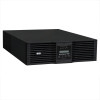Tripp Lite SU10000RT3UPM Owner's Manual for SmartOnline 8kVA-10kVA UPS 932897 - Page 9
Manual Bypass Operation, Optional Connection continued - battery replacement
 |
View all Tripp Lite SU10000RT3UPM manuals
Add to My Manuals
Save this manual to your list of manuals |
Page 9 highlights
Optional Connection (continued) 2 EPO Port Connection This optional feature is only for those applications that require connection to a facility's Emergency Power Off (EPO) circuit. When the UPS is connected to this circuit, it enables emergency shutdown of the UPS's inverter and inhibits transfer to internal bypass. Using the cable provided, connect the EPO port of your UPS (see 2a) to a user-supplied normally closed or normally open switch according to the circuit diagram (see 2b). Note: 2a 1. If using a cable other than what is supplied, the cable should not exceed 350 feet or have a resistance of greater than 10 ohms. 2. If a non-latching EPO switch is used, the EPO must be held for a minimum of 1 second. This does not apply to a latching EPO switch. CAUTION: The EPO port is not a phone line surge suppressor; do not connect a phone line to this port. EPO PIN ASSIGNMENT 12V 1 X 2 3 4 1K 5 X 6 UPS Unit State when asserting EPO with AC line present: 2b LEDs Output Fans Serial SNMP USB LCD Screen OFF OFF OFF OFF OFF OFF "Emergency Stop" To restart the UPS unit after asserting EPO with AC line present: 1. Verify that the EPO assertion has been removed or cleared. 2. Remove AC line power to the UPS unit. 3. Reapply AC line power. Now the UPS will start back up in Bypass mode and the LCD will display "BYPASS MODE". UPS Unit State when asserting EPO without AC line power: LEDs Output Fans Serial SNMP OFF OFF OFF OFF OFF USB LCD Screen OFF "Emergency Stop" To restart the UPS unit after asserting EPO without AC line power: 1. Verify that the EPO assertion has been removed or cleared. 2. Reapply AC line power to the UPS unit. Now the UPS will start back up in Bypass mode and the LCD will display "BYPASS MODE". 3 Internal SNMP/WEB Card Insertion Remove the small cover panel from the accessory slot to use optional accessories to remotely monitor and control your UPS. Visit www.tripplite.com/support for more information, including a list of available SNMP, network management and connectivity products. 3 Manual Bypass Operation (for power module maintenance or replacement) The UPS system includes a self-contained power/battery module along with an independent, detachable PDU with a bypass switch. This switch allows qualified service personnel to remove the detachable PDU from the power/battery module for routine maintenance without disrupting power to connected loads. While this switch is set to "BYPASS", connected equipment will receive unfiltered AC utility power, but the equipment will not receive battery power in the event of a blackout. Note: If desired, an optional hardwire detachable PDU is also available separately from Tripp Lite. Contact Tripp Lite for details. (Optional: During a hot-swap, the PDU can be housed in the back of the rack configuration using supplied PDU hanger brackets and hardware. See STEP 5 on page 3 for mounting instructions.) WARNING! For qualified service personnel only. Failure to follow the bypass procedure completely will not adequately power down the UPS power/battery module, resulting in the continued risk of death or injury from potential contact with high voltage. The UPS's power/ battery module and detachable PDU are extremely heavy. This procedure requires several people to perform. 9 201102160 93-2897.indb 9 3/30/2011 9:30:47 AM















